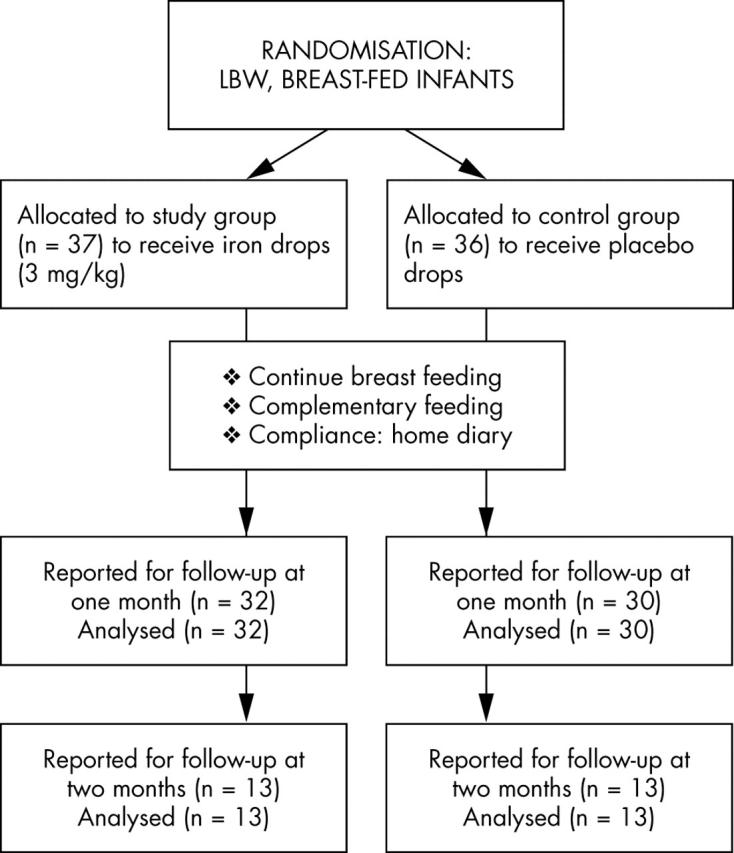Abstract
Aims: To determine the haematological effects of iron supplementation in predominantly breast fed term low birth weight (LBW) infants.
Methods: Seventy three healthy term LBW (<2500 g), predominantly breast fed infants aged 50–80 days were randomised into two groups to receive either iron (3 mg/kg/day) (iron supplemented (IS) group; n = 37) or placebo drops (placebo (P) group; n = 36). Haematological parameters and anthropometry were measured at baseline and repeated after four and eight weeks.
Results: A total of 62 subjects (32 in the IS group and 30 in the P group) came for the first follow up and 26 (13 in the IS group and 13 in the P group) reported for the second visit. There were no significant differences in serum ferritin and anthropometry. However, covariates (infant age, haemoglobin, and ferritin, and maternal haemoglobin) adjusted haemoglobin change was significantly higher in the IS group after four weeks (4.6 g/l; 95% CI 0.5 to 8.8) and eight weeks (8.6 g/l; 95% CI 1.8 to 15.4).
Conclusions: Iron supplementation in a therapeutic dose in term breast fed LBW infants results in a marginal increase in haemoglobin. The functional benefit of this haemoglobin rise requires further evaluation.
Full Text
The Full Text of this article is available as a PDF (140.4 KB).
Figure 1.

Summary of study design.
Selected References
These references are in PubMed. This may not be the complete list of references from this article.
- Barclay S. M., Aggett P. J., Lloyd D. J., Duffty P. Reduced erythrocyte superoxide dismutase activity in low birth weight infants given iron supplements. Pediatr Res. 1991 Mar;29(3):297–301. doi: 10.1203/00006450-199103000-00015. [DOI] [PubMed] [Google Scholar]
- Gera Tarun, Sachdev H. P. S. Effect of iron supplementation on incidence of infectious illness in children: systematic review. BMJ. 2002 Nov 16;325(7373):1142–1142. doi: 10.1136/bmj.325.7373.1142. [DOI] [PMC free article] [PubMed] [Google Scholar]
- Jansson L., Holmberg L., Ekman R. Medicinal iron to low birth weight infants. Acta Paediatr Scand. 1979 Sep;68(5):705–708. doi: 10.1111/j.1651-2227.1979.tb18442.x. [DOI] [PubMed] [Google Scholar]
- Lardi A. M., Hirst C., Mortimer A. J., McCollum C. N. Evaluation of the HemoCue for measuring intra-operative haemoglobin concentrations: a comparison with the Coulter Max-M. Anaesthesia. 1998 Apr;53(4):349–352. doi: 10.1046/j.1365-2044.1998.00328.x. [DOI] [PubMed] [Google Scholar]
- Olivares M., Llaguno S., Marin V., Hertrampf E., Mena P., Milad M. Iron status in low-birth-weight infants, small and appropriate for gestational age. A follow-up study. Acta Paediatr. 1992 Oct;81(10):824–828. doi: 10.1111/j.1651-2227.1992.tb12111.x. [DOI] [PubMed] [Google Scholar]
- Revenant M. C. "Sandwich" enzyme immunoassay for serum ferritin with polypropylene test tubes as the solid phase. Clin Chem. 1983 Apr;29(4):681–683. [PubMed] [Google Scholar]
- Scott P. H., Berger H. M., Kenward C., Scott P., Wharton B. A. Effect of gestational age and intrauterine nutrition on plasma transferrin and iron in the newborn. Arch Dis Child. 1975 Oct;50(10):796–798. doi: 10.1136/adc.50.10.796. [DOI] [PMC free article] [PubMed] [Google Scholar]


